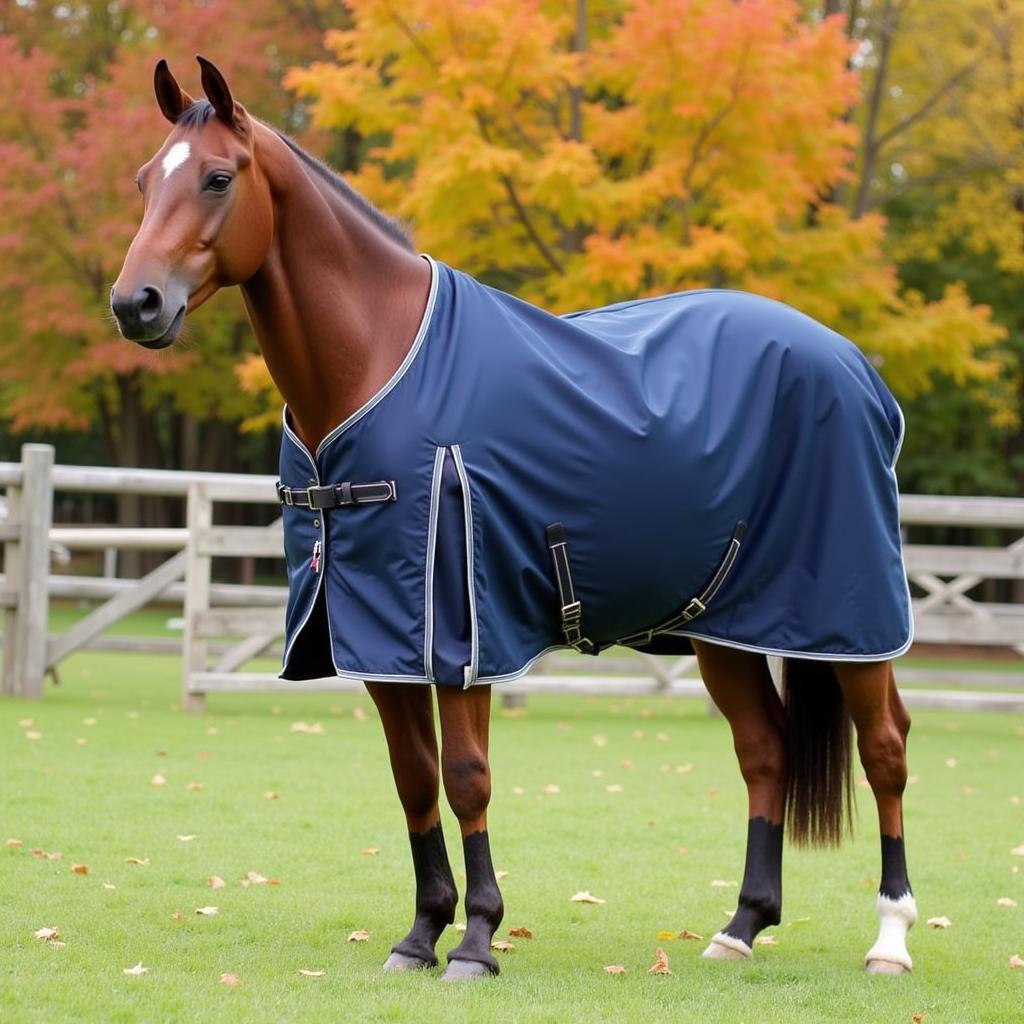A horse in a jacket is a sight that never fails to charm. But equine outerwear serves more than just an aesthetic purpose. Just like us, horses can benefit from an extra layer of warmth when temperatures drop. Choosing the right horse jacket, however, depends on a variety of factors, from your horse’s breed and activity level to the weather conditions you’re facing.
Why Does Your Horse Need a Jacket?
Horses, despite their size and strength, can be susceptible to the cold, especially:
- Clipped Horses: Horses with their winter coats shaved off need an extra layer of protection, especially during riding or turnout.
- Senior Horses: Older horses often have a harder time regulating body temperature.
- Sick or Recovering Horses: A jacket can help maintain a consistent body temperature for horses recovering from illness or injury.
- Certain Breeds: Thinner-coated breeds like Thoroughbreds may need a jacket in colder climates.
 Horse Wearing a Winter Turnout Jacket
Horse Wearing a Winter Turnout Jacket
Types of Horse Jackets
There is a wide range of horse jackets available, each tailored to specific needs:
- Stable Blankets: Ideal for horses stabled during colder months, these jackets provide warmth while the horse is resting.
- Turnout Blankets: Designed for horses spending time outdoors, these jackets are typically waterproof and breathable to withstand the elements.
- Coolers: Lightweight and breathable, coolers help dry a horse’s sweat after exercise and prevent chills.
- Fly Sheets: These mesh jackets protect horses from pesky insects during the warmer months.
- Exercise Sheets: Worn during riding, these lightweight jackets help keep muscles warm and prevent chills.
 A Grey Horse Wearing a Lightweight Exercise Sheet
A Grey Horse Wearing a Lightweight Exercise Sheet
Choosing the Right Fit: How to Measure Your Horse for a Jacket
A well-fitted jacket is essential for your horse’s comfort and safety. Here’s a step-by-step guide on how to measure your horse:
- Use a Soft Tape Measure: A flexible tape measure will ensure accurate measurements.
- Start at the Center of the Chest: Place the tape measure at the center point of the horse’s chest, just behind the withers.
- Measure to the Point of the Buttock: Extend the tape measure along the horse’s side to the point of the buttock, ensuring it follows the contours of the body.
- Record the Measurement in Inches: This number, rounded up to the nearest inch, is your horse’s blanket size.
Remember, different brands may have slight variations in sizing, so always refer to the manufacturer’s size chart.
“A well-fitted jacket should lie smoothly over the horse’s body without restricting movement or causing any rubbing,” says renowned equine veterinarian Dr. Emily Carter.
Fabric and Features: What to Look For
- Breathability: Choose fabrics like nylon or polyester that allow air to circulate, preventing your horse from overheating.
- Waterproofing: Opt for turnout jackets with a waterproof outer layer to keep your horse dry in wet conditions.
- Durability: Look for jackets made from rip-stop fabric, especially for horses prone to getting into mischief.
- Linings: Fleece or quilted linings provide extra warmth for colder climates.
- Closures: Secure closures like buckles, surcingles, and leg straps ensure the jacket stays in place.
Caring for Your Horse’s Jacket
Proper care will extend the life of your horse’s jacket:
- Regular Cleaning: Follow the manufacturer’s instructions for washing. Most jackets can be machine washed on a gentle cycle.
- Air Drying: Hang the jacket to dry completely before storing.
- Storage: Store clean and dry jackets in a cool, dry place.
Horse in Jacket: A Sign of a Caring Owner
Investing in a horse jacket demonstrates your commitment to your equine companion’s well-being. Whether it’s a cozy stable blanket for chilly nights or a waterproof turnout jacket for braving the elements, the right jacket will help keep your horse comfortable, healthy, and looking their best.
Remember, choosing a horse jacket is a personal decision. Consider your horse’s individual needs and your local climate to make the best choice.
FAQ
Q: Do all horses need jackets in the winter?
A: Not all horses require jackets in the winter. Factors like breed, age, health, and whether the horse is clipped or living outdoors influence the need for a jacket.
Q: Can I leave a jacket on my horse overnight?
A: It’s generally safe to leave a well-fitted turnout jacket on your horse overnight, provided it’s designed for 24/7 wear and the weather conditions are appropriate. However, always check the jacket and your horse in the morning to ensure everything is still secure and comfortable.
Q: How can I prevent my horse from destroying their jacket?
A: Choosing a durable jacket made from rip-stop fabric is a good start. Ensuring a proper fit and providing your horse with ample hay and mental stimulation can also help prevent destructive behavior.
Q: What are the best types of jackets for horses with sensitive skin?
A: Look for jackets lined with soft, hypoallergenic materials like fleece or smooth nylon. Avoid materials that might irritate sensitive skin, such as rough wool or scratchy tags.
For more information about specific types of horse jackets, check out our dedicated pages on:
- childrens horse riding jackets
- horse riding jackets mens
- horse hunting jackets
- women’s horse riding jacket
- horse riding airbag jacket
Need help choosing the perfect jacket for your equine partner? Contact us at Phone Number: 0772127271, Email: [email protected], or visit us at QGM2+WX2, Vị Trung, Vị Thuỷ, Hậu Giang, Việt Nam. Our dedicated team is available 24/7 to assist you.